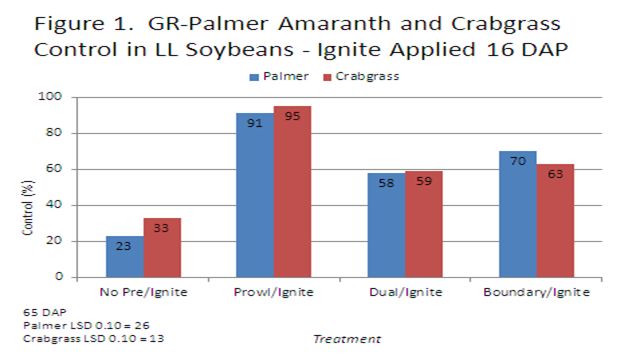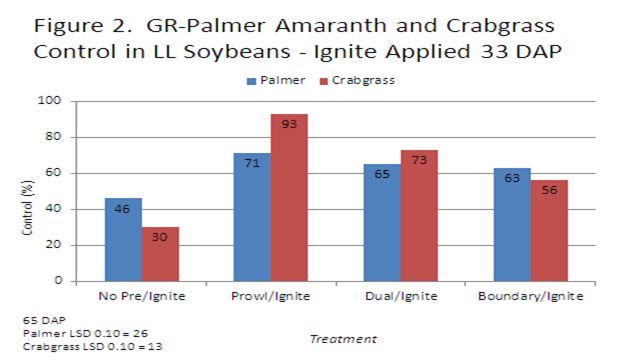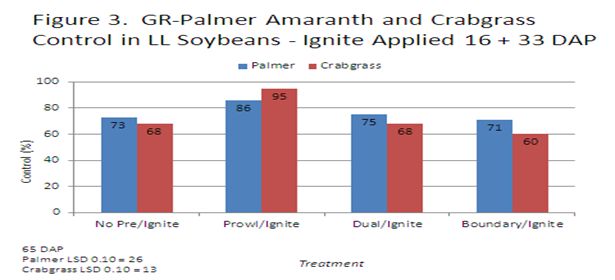Journal of the NACAA
ISSN 2158-9429
Volume 4, Issue 1 - June, 2011
Managing Glyphosate-Resistant Palmer Amaranth In Liberty Link Soybeans
- Kichler, J.M., Macon County Extension Coordinator, UGA Cooperative Extension
Prostko, E.P., UGA Extension Soybean Weed Specialist, Department of Crop and Soil Sciences
ABSTRACT
Glyphosate-resistant Palmer amaranth (Amaranthus palmeri) was confirmed in Macon County, Georgia in 2005. In 2010, one on-farm field trial was conducted in Macon County to evaluate Ignite based programs for the control of glyphosate resistant Palmer amaranth in Liberty Link soybeans. The results suggest that glyphosate resistant Palmer amaranth will only be controlled using a systems approach that consists of both preemergence and postemergence herbicides.
Introduction
Glyphosate-resistant Palmer amaranth (Amaranthus palmeri) was confirmed in Macon County, Georgia in 2005 (Culpepper et al, 2006). Dryland crop production is being threatened by glyphosate resistant Palmer amaranth due to erratic rainfall patterns during planting time. These erratic rainfall patterns have made the activation of residual herbicides very difficult. Residual herbicides are the foundation of weed management programs for glyphosate resistant Palmer amaranth. Ignite based programs in Liberty Link cotton offer growers a greater potential to control glyphosate resistant Palmer amaranth than do Roundup based programs, especially in dryland production (Culpepper et al, 2011). Area growers are interested in Ignite based programs in dryland soybeans but few Liberty Link soybean varieties are available for this area. As more varieties come into the market place for area growers then weed management systems need to be developed for Ignite based systems in soybean.
Material and Methods
A field experiment was conducted in 2010 in Macon County, Georgia to evaluate glyphosate resistant Palmer amaranth control using Liberty Link weed systems in soybeans. The soybeans were planted in 36 inch rows on April 21, 2010 with an air planter. The plot size was 2 rows by 20 feet long. All herbicide treatments were applied with a CO2 powered backpack sprayer calibrated to deliver 15 GPA with 11002DG flat fan nozzle tips. Rainfall (1.3 inches) occurred 3 days after the preemergence herbicides were applied. Traditional small plot techniques were used and all treatments were replicated 4 times.
This field experiment evaluated 16 herbicide treatments to control glyphosate-resistant Palmer amaranth in Liberty Link soybeans. The treatments consisted of combinations of preemergence and/or postemergence herbicides in order to develop herbicide systems for GR Palmer amaranth control a Liberty Link system. The preemergence herbicides included Boundary® (s-metolachlor + metribuzin)1, Prowl® H20 (pendimethalin)2, and Dual Magnum (s-metolachlor)3. The postemergence herbicide was Ignite (gluphosinate)4. The postemergence herbicide was applied at 2 different timings which included POST 1 or 16 Days after Planting (DAP), and POST 2 or 33 DAP. Palmer amaranth and crabgrass was evaluated for control. The treatments for this test are shown in Table 1.
Table 1. Herbicide Treatments and Timing for Glyphosate Resistant Palmer amaranth control in a Liberty Link System, Macon County, GA 2010
|
Treatment |
Herbicide Timings |
||
|
PRE |
POST 1 (16 DAP) |
POST 2 (33 DAP) |
|
|
1 |
|
|
|
|
2 |
|
Ignite 280 22 oz/A |
|
|
3 |
|
|
Ignite 280 22 oz/A |
|
4 |
|
Ignite 280 22 oz/A |
Ignite 280 22 oz/A |
|
5 |
Prowl H20 2.0 pts/A |
|
|
|
6 |
Prowl H20 2.0 pts/A |
Ignite 280 22 oz/A |
|
|
7 |
Prowl H20 2.0 pts/A |
|
Ignite 280 22 oz/A |
|
8 |
Prowl H20 2.0 pts/A |
Ignite 280 22 oz/A |
Ignite 280 22 oz/A |
|
9 |
Dual Magnum 1.0 pt/A |
|
|
|
10 |
Dual Magnum 1.0 pt/A |
Ignite 280 22 oz/A |
|
|
11 |
Dual Magnum 1.0 pt/A |
|
Ignite 280 22 oz/A |
|
12 |
Dual Magnum 1.0 pt/A |
Ignite 280 22 oz/A |
Ignite 280 22 oz/A |
|
13
|
Boundary 1.5 pt/A |
|
|
|
14 |
Boundary 1.5 pt/A |
Ignite 280 22 oz/A |
|
|
15 |
Boundary 1.5 pt/A |
|
Ignite 280 22 oz/A |
|
16 |
Boundary 1.5 pt/A |
Ignite 280 22 oz/A |
Ignite 280 22 oz/A |
Pre = April 21, 2010, Post 1 = May 7, 2010, 1 to 2 inch Palmer amaranth, 1 to 2 inch Crabgras, Post 2 = May 24, 2010, 3 to 9 inch Palmer amaranth, 4 to 5 inch Crabgrass
Results
Figure 1 shows Glyphosate resistant Palmer amaranth and crabgrass control in Liberty Link soybeans when Ignite was applied at the POST 1 or 16 DAP timing. Palmer amaranth and crabgrass control was evaluated at 65 DAP. The least effective treatments was single applications of Ignite where applied postemerge without a preemerge herbicide control of Palmer amaranth was 23 percent and crabgrass was 33 percent. The most effective treatment was when Ignite was applied at POST 1 or 16 DAP with a Prowl applied preemerge then control of Palmer amaranth improved to 91 percent and crabgrass control improved to 95 percent.

Figure 2 shows Glyphosate resistant Palmer amaranth and crabgrass control in Liberty Link soybeans when Ignite was applied at POST 2 or 33 DAP. There were no significant differences in Palmer amaranth control between any of the herbicide treatments. The least effective crabgrass treatment was Ignite applied without a preemerge herbicide in the system. Crabgrass control was 30 percent. Crabgrass control ranged from 71 to 63 percent with Ignite applications that had a preemerge herbicide in the system.

Figure 3 shows Glyphosate resistant Palmer amaranth and crabgrass control in Liberty Link soybeans when Ignite was applied at twice at POST 1 or 16 DAP and POST 2 or 33 DAP. There were no significant differences in Palmer amaranth control between all treatments. The treatment with Ignite and Prowl applied preemerge was the most effective on crabgrass and there was no significant differences between the other treatments for crabgrass control.

Growers need to use preemerge residual herbicides on weed management programs for glyphosate resistant Palmer amaranth. The Prowl applied preemerge with Ignite applied postemerge at 16 DAP was the most effect treatment for Palmer amaranth control. Weed size is critical for Ignite based systems for Palmer amaranth control.
Sources of Materials
1 Boundary®, s-metolachlor + metribuzin, Syngenta Crop Protection, Inc., P.O. Box 18300, Greensboro, NC 27419.
2 Prowl® H2O, pendimethalin, BASF Ag Products, P.O. Box 13528, 26 Davis Drive, Research Triangle Park, NC 27709-3528.
3Dual Magnum®, s-metolachlor, Syngenta Crop Protection, Inc., P.O. Box 18300, Greensboro, NC 27419.
4 Ignite®, gluphosinate, Bayer CropScience, P.O. Box 12014, Research Triangle Park RTP, North Carolina 27709.
References
Culpepper, A.S., Grey, T.L., Vencill, W.K., Kichler, J.M., Webster, T.M., Brown, S.M., Davis, J.W., and Hanna, W.W. (2006). “Glyphosate-resistant Palmer Amaranth (Amaranthus palmeri) confirmed in Georgia.” Weed Science, vol 54, pg. 620-626.
Culpepper, A.S., Kichler, J.M., Sosnoskie, L.M. (2011). “University of Georgia Herbicide Programs for Controlling Moderate to Severe Populations of Glyphosate Resistant Palmer Amaranth Control in 2011 Cotton.” University of Georgia Cooperative Extension Circular #952.
